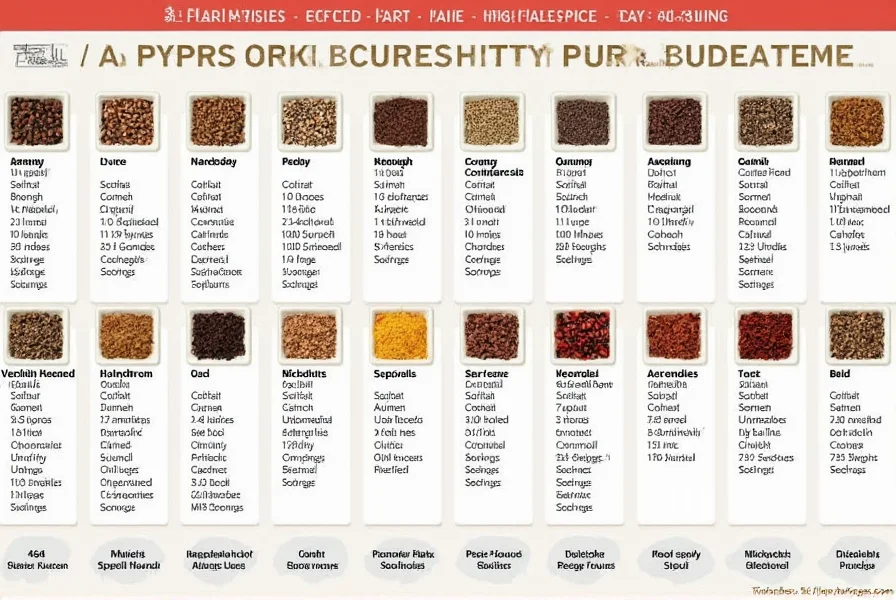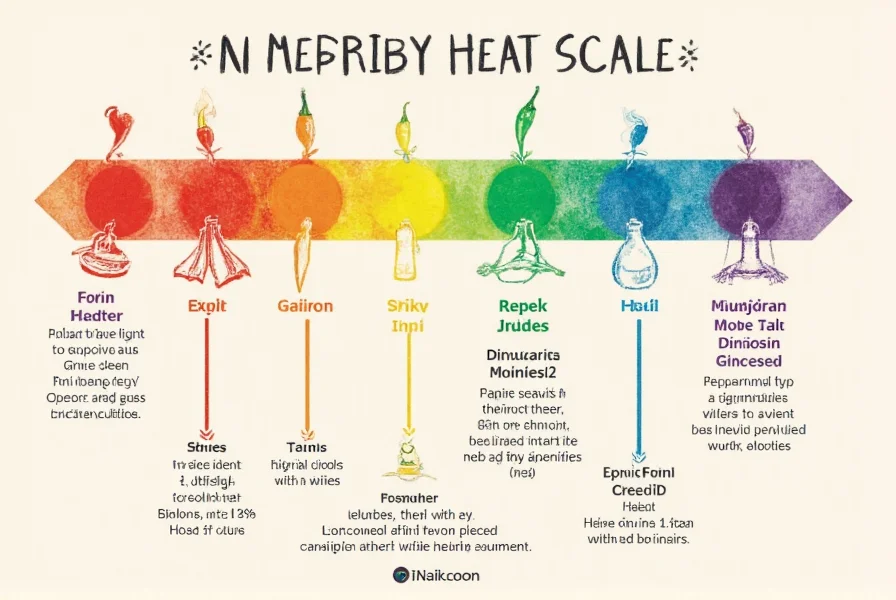Pepper Chart: Heat Levels and Uses
| Pepper Name | Heat Level (SHU) | Flavor Profile | Common Uses |
|---|---|---|---|
| Jalapeño | 2,500 – 8,000 | Mild, slightly sweet, grassy | Guacamole, salsas, stuffed peppers |
| Serrano | 10,000 – 25,000 | Pungent, sharp, slightly fruity | Hot sauces, pickling, salsas |
| Habanero | 100,000 – 350,000 | Smoky, citrusy, floral | Caribbean dishes, hot sauces, marinades |
| Bell Pepper | 0 – 100 | Sweet, crunchy, mild | Stir-fries, roasting, salads |
| Cayenne | 30,000 – 50,000 | Sharp, tangy, slightly smoky | Spicy rubs, hot sauces, seasoning blends |
| Ghost Pepper | 850,000 – 1,041,450 | Smoky, earthy, intensely hot | Indian curries, hot sauces, challenge foods |
| Carolina Reaper | 1,400,000 – 2,200,000 | Earthy, smoky, extremely hot | Heat challenges, specialty hot sauces |
Understanding pepper heat levels and flavors is essential for cooking success. This chart provides clear comparisons of Scoville Heat Units (SHU), flavor profiles, and culinary applications for popular peppers. Whether you're a beginner or experienced cook, use this guide to select the perfect pepper for any dish.
Practical Tips for Pepper Lovers
- Start Small: If you're new to spicy food, begin with milder peppers like jalapeños or bell peppers. Gradually work your way up as your tolerance increases.
- Know Your Limits: Don’t force yourself to eat something if it’s too hot. Respect your body and adjust accordingly.
- Use Gloves: When handling hot peppers, always wear gloves to avoid transferring capsaicin to your skin or eyes.
- Pair with Dairy: Milk, yogurt, or cheese can help neutralize the heat from peppers.
- Experiment with Dishes: Try incorporating different peppers into your favorite recipes to discover new flavors and heat levels.

Buying Guide: How to Choose the Right Peppers
Choosing the right peppers depends on your taste, cooking style, and the occasion. Our chart makes it easier than ever to find what you need.
Top Picks for Different Occasions
- For Everyday Cooking: Bell peppers, jalapeños, and serranos are great all-around choices. They add flavor without overwhelming heat.
- For Spicy Dishes: Habaneros, ghost peppers, and cayennes are perfect for adding a kick to your meals. Ideal for curries, salsas, and hot sauces.
- For Heat Challenges: Carolina reapers and other ultra-hot peppers are best suited for experienced spice lovers who want to push their limits.
- For Special Occasions: Use unique peppers like the Thai bird’s eye or the African bird pepper to impress guests at parties or gatherings.
When buying peppers, look for firm, bright-colored, and unblemished ones. Avoid any that feel soft or have visible mold.

Frequently Asked Questions
What is the mildest pepper on the chart?
Bell peppers are the mildest with 0-100 SHU. They contain no capsaicin and offer a sweet, crunchy flavor perfect for beginners.
How do I handle extremely hot peppers safely?
Always wear nitrile gloves when cutting super-hots like Ghost Peppers or Carolina Reapers. Work in a well-ventilated area, avoid touching your face, and wash tools thoroughly with soapy water afterward.
Can I substitute habaneros for jalapeños in recipes?
Proceed with caution! Habaneros (100,000-350,000 SHU) are 20-40x hotter than jalapeños (2,500-8,000 SHU). Use 1/4 to 1/2 of a habanero in place of one jalapeño, and remove seeds/membranes for less heat.
Why do my hands burn after handling jalapeños?
Capsaicin residue remains on skin even after washing. Relieve the burn with rubbing alcohol or oil (which dissolves capsaicin), followed by soap. Never use water alone—it spreads the oil.
What pepper gives smoky flavor without extreme heat?
Chipotle peppers (smoked jalapeños) or New Mexico chiles (5,000-10,000 SHU) provide deep smokiness at manageable heat levels. Add to stews, rubs, or salsas for complexity.
How long do fresh peppers last in the refrigerator?
Most peppers stay crisp for 1-2 weeks in a perforated plastic bag in the crisper drawer. Hotter varieties like habaneros last longer (up to 3 weeks) due to higher capsaicin content acting as a natural preservative.
Does cooking reduce pepper heat?
Heat distribution becomes more even when cooked, but total capsaicin remains stable. Simmering in dairy (like coconut milk in curries) temporarily binds capsaicin, creating a milder eating experience.










 浙公网安备
33010002000092号
浙公网安备
33010002000092号 浙B2-20120091-4
浙B2-20120091-4